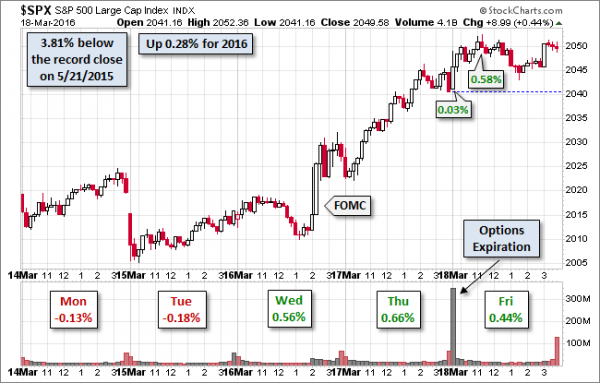Once again, this week’s economic calendar is very light. There will be plenty of political news and daily doses of FedSpeak. Despite the political stories, I expect the punditry to be asking:
What is happening with housing?
Prior Theme Recap
In my last WTWA (two weeks ago) I predicted a focus on the US Presidential election and the possible implications for financial markets. That was a good guess, with these stories remaining at the forefront of news through two weeks, not just one. Last week included the expected news about the Fed even though the expected news was no real policy change! Doug Short notes the post-Fed rally, as you can see from his excellent weekly chart. (With the ever-increasing effects from foreign markets, you should also add Doug’s weekly chart to your reading list).

Doug’s update also provides multi-year context. See his weekly chart for more excellent charts and analysis.
We would all like to know the direction of the market in advance. Good luck with that! Second best is planning what to look for and how to react. That is the purpose of considering possible themes for the week ahead. You can make your own predictions in the comments.
This Week’s Theme
The economic calendar is light and the U.S. has a four-day trading week. The President’s trip to Cuba and South America will make news, but probably not financial news. Daily servings of speeches from Fed participants will provide plenty of material for those who always see that subject as most important.
Despite this competition, I expect attention to the role of the housing market in the current economy. Employment remains strong. Auto sales are solid. Retail sales are good. Business investment and housing remain the biggest economic question marks. At one point both were a real drag on economic growth. More recently the effect has been flat rather than negative. With some key data released this week, I expect pundits to be asking: What’s up with housing.
Background
Calculated Risk is the “go to source on housing” according to Paul Krugman. For those who are not fans of Krugman, I have said the same thing many timesJ Bill called both the top of the housing market in 2006 and the bottom in early 2012. Very few can claim that distinction. His blog has become a top source for coverage of economic news, earning widespread respect. We should be paying attention to his perspective this week.
Viewpoints
Those bearish on the housing market (and often on the economy and stocks in general) frequently cite the following points:
Those who are bullish observe the following:
As always, I have my own opinion in the conclusion. But first, let us do our regular update of the last week’s news and data. Readers, especially those new to this series, will benefit from reading the background information.
Last Week’s Data
Each week I break down events into good and bad. Often there is “ugly” and on rare occasion something really good. My working definition of “good” has two components:
The Good
There was some good news last week, but it was only marginally positive.









Leave A Comment